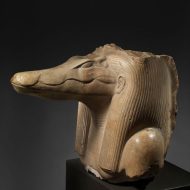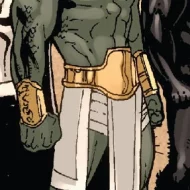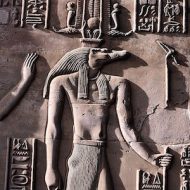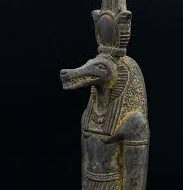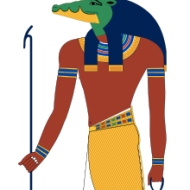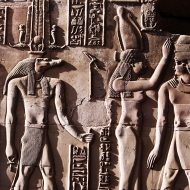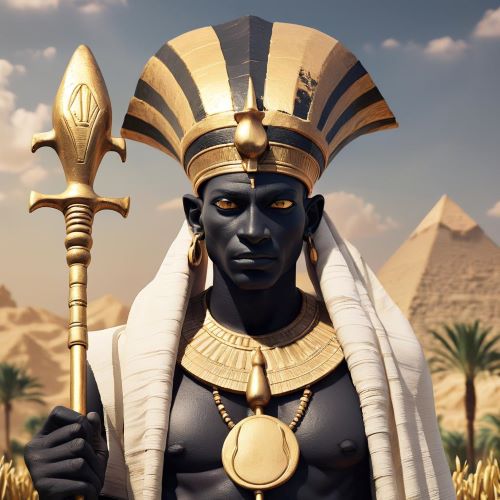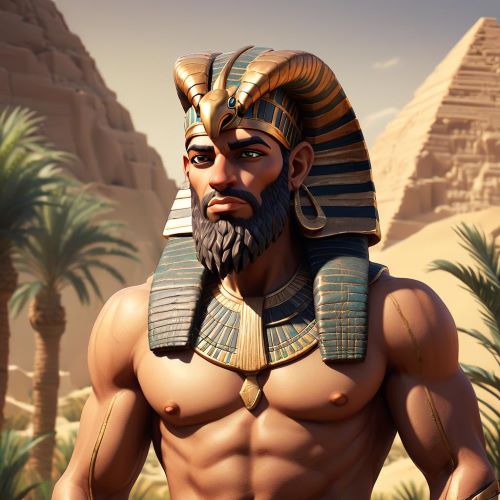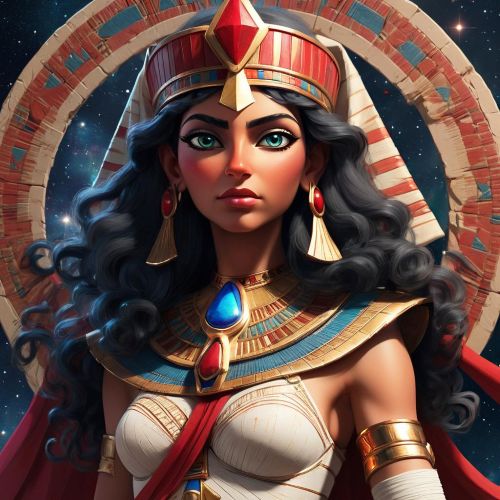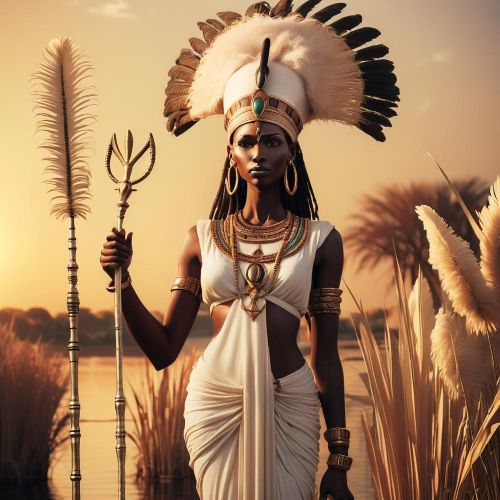Sobek : The Crocodile God
Listen
At a glance
| Description | |
|---|---|
| Origin | Egyptian Mythology |
| Classification | Gods |
| Family Members | Renenutet (Wife), Khonsu (Son) |
| Region | Egypt |
| Associated With | Nile, Crocodiles |
Sobek
Introduction
Sobek, one of the most intriguing deities in Egyptian mythology, embodied both the ferocity of the crocodile and the vital life force of the Nile. Among the earliest references to him appear in the Pyramid Texts of the Old Kingdom, where he is described as a primordial force who emerged from the chaotic waters of Nun. Some traditions claim that Sobek not only created the Nile but also ruled the universe at its earliest stage, linking him to both cosmic order and natural chaos. His dual nature reflected the crocodile’s role in Egyptian life—an animal both feared and revered.
On one hand, Sobek represented danger, swiftness, and predatory power. On the other, he was deeply associated with fertility, water, and protection. People prayed to Sobek not only to appease crocodiles in the Nile but also to ensure agricultural abundance and human reproduction. In this sense, he embodied the paradox of Egyptian religion: a god who could destroy but also sustain life.
Sobek’s worship was especially strong in the Faiyum region, where live crocodiles were kept in sacred pools and revered as earthly manifestations of the god. These crocodiles were fed lavishly and, upon death, carefully mummified and buried in special cemeteries. During the Middle Kingdom, Sobek’s cult gained prominence, particularly when he was merged with the solar deity Ra to form Sobek-Ra, a crocodile-sun god embodying immense creative and destructive powers. His worship continued well into the Ptolemaic and Roman eras, proving his enduring significance in Egyptian spirituality.
Physical Traits
Sobek’s iconography highlights his connection to both animal ferocity and divine authority. He was most commonly depicted as a man with the head of a crocodile, a sharp-toothed grin emphasizing his predatory nature. On his head, Sobek often wore the Hemhem crown adorned with ostrich feathers and the Uraeus cobra, symbols of power, protection, and kingship. At times, he bore the solar disk above his head, reflecting his association with Ra and his role as a solar deity.
In other depictions, Sobek appeared as a full crocodile, emphasizing his raw connection to the Nile and its dangerous waters. His sacred symbols included the ankh, representing fertility and life; the was-scepter, symbolizing dominion and divine authority; and the water lily, a sign of rebirth and renewal. Through these images, Sobek stood as a god of transformation—an unpredictable force who could both take life and grant it.
Family
The origins of Sobek are complex, with multiple traditions offering different parentage for the crocodile god. One version portrays him as the son of the war goddess Neith and the chaotic storm god Set, aligning him with violence and unpredictability. Another tradition claims Sobek was the offspring of Neith and Khnum, the ram-headed potter god who fashioned humans on his wheel. This version highlights Sobek’s protective and creative aspects, inherited from his mother’s nurturing nature.
Other accounts describe Sobek as being created by Horus himself, who fertilized an egg with the help of a crocodile, symbolizing a fusion of solar and aquatic power. Sobek’s consort was often identified as Renenutet, the serpent goddess of harvest and nourishment, who protected crops and farmers. Together, they had a son, Khonsu, the lunar god of time, linking Sobek’s family to the cycles of fertility, time, and rebirth.
Other Names
Sobek’s name itself derives from the Egyptian word meaning “to impregnate” or “to cause to be fertile,” underlining his strong association with virility and procreation. Over time, he was known by several variations of his name, including Sebek, Sobki, Sochet, and Sobk. His syncretic form Sobek-Ra also carried enormous prestige, representing the blending of solar and aquatic powers in one divine entity.
Powers and Abilities
Sobek’s powers reflected his deep connection to the Nile, fertility, and the primal force of crocodiles. One creation myth describes how he generated the Nile itself through his sweat, ensuring the river’s constant renewal and the fertility of the land. In some accounts, Sobek laid eggs upon the primordial waters, symbolizing both creation and continuity.
As a fertility god, Sobek was invoked by women seeking children and by farmers praying for abundant harvests. His virility was legendary, embodying raw generative power. Farmers in regions dedicated to Sobek offered sacrifices to ensure fertile soil and plentiful crops. His connection to water lilies also symbolized cycles of regeneration, further linking him to birth and renewal.
As lord of crocodiles, Sobek embodied immense strength, aggression, and protective force. The crocodile was both feared for its ability to strike suddenly and revered as a guardian of waters. Sobek’s worshippers believed that the god’s strength protected them from the dangers of the Nile, even as they honored him to avoid its perils. Live crocodiles in his temples were treated as manifestations of Sobek’s power, revered in life and ritually mummified after death.
Sobek’s fusion with Ra expanded his powers dramatically. As Sobek-Ra, he embodied the creative force of the sun as well as the regenerative power of water. This dual role made him a cosmic god of unparalleled influence—able to control fertility, time, and creation itself, while also wielding the destructive might of both the sun and the crocodile.
Modern Day Influence
Sobek’s legacy continues to thrive in modern culture, where his fierce image and dual nature have made him a popular figure in video games, literature, and popular media. In the video game Smite, Sobek appears as a playable deity whose crocodilian abilities allow him to control battlefields with aggression and crowd-control tactics. In Assassin’s Creed Origins, Sobek is featured prominently in the storyline, depicted as a massive crocodile god whose cult was central to Egyptian life.
Beyond gaming, Sobek’s influence has seeped into science fiction and comic books. In the Star Wars universe, Sobek is referenced as the name of a brutal alien species known for its raw power and ferocity. In DC Comics, Sobek appears as a crocodile-man villain associated with the Four Horsemen, underscoring his association with chaos and destruction.
Though thousands of years removed from his temples in Faiyum, Sobek remains a compelling figure, embodying the eternal balance of danger and fertility, chaos and creation. His crocodile form continues to fascinate modern audiences, keeping alive the mystery of one of Egypt’s most powerful and paradoxical gods.
Related Images
Sources
Wikipedia contributors. (2025, September 11). Sobek. In Wikipedia. Retrieved from https://en.wikipedia.org/wiki/Sobek Wikipedia
Ancient-Origins. (2018, December 6). Sobek, the Crocodile God who Sweated the Nile. Retrieved from https://www.ancient-origins.net/ancient-places-europe/sobek-0011114 Ancient Origins
Egyptian Museum Online. (n.d.). Sobek. Retrieved from https://egyptianmuseum.org/deities-sobek egyptianmuseum.org
Ancient Egypt Online. (n.d.). Sobek: The Crocodile God of Strength and Power. Retrieved from https://www.ancient-egypt-online.com/sobek.html ancient-egypt-online.com
ARCE (American Research Center in Egypt). (n.d.). The Rise of Sobek in the Middle Kingdom. Retrieved from https://arce.org/resource/rise-sobek-middle-kingdom/ ARCE
AncientEgypt101.com. (n.d.). The Crocodile God. Retrieved from https://www.ancientegypt101.com/crocodile-god.html Ancient Egypt 101 by Mummific
Britannica. (n.d.). Ancient Egyptian gods and goddesses. Retrieved from https://www.britishmuseum.org/learn/schools/ages-7-11/ancient-egypt/ancient-egyptian-gods-and-goddesses (Note: This British Museum page includes Sobek among many deities.) British Museum
Frequently Asked Questions
What is Sobek the god of?
Sobek is the Egyptian god of the Nile, crocodiles, fertility, and protection. He embodied the strength and ferocity of crocodiles while also being worshipped as a fertility deity who ensured bountiful harvests and healthy offspring. Sobek was also linked to kingship, serving as a protector of the pharaohs and symbolizing their power.
Is Sobek good or evil?
Sobek is neither fully good nor evil—he embodies both danger and protection. Feared for his crocodile nature, he was also revered as a life-giver, protector, and god of fertility in Egyptian mythology.
Who is the wife of Sobek?
Sobek is often linked with the goddess Renenutet, the deity of nourishment and harvest. In some traditions, he is also paired with Hathor or Heqet, reflecting his role as a fertility and protective god in Egyptian mythology.
Where was Sobek worshipped?
His most important cult center was in the Faiyum region, especially at Crocodilopolis, where live crocodiles were kept in sacred pools, adorned with jewels, and mummified after death.
Does Sobek appear in modern culture?
Definitely. Sobek shows up as a playable god in the video game Smite, as a boss figure in Assassin’s Creed Origins, and even as a crocodile-inspired character in DC Comics and Star Wars.


